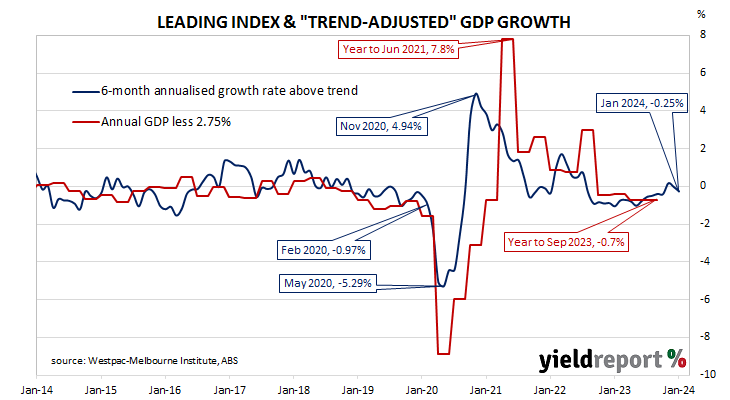Summary: Leading index growth rate down in January; economy stuck in below-trend growth rut; reading implies annual GDP growth of around 2.5%; ACGB yields decline modestly; rate-cut expectations firm; set to remain subdued in near-term but growth pulse improved in last 12 months.
Westpac and the Melbourne Institute describe their Leading Index as a composite measure which attempts to estimate the likely pace of Australian economic growth in the short-term. After reaching a peak in early 2018, the index trended lower through 2018 and 2019 before plunging to recessionary levels in the second quarter of 2020. Subsequent readings spiked towards the end of 2020 but then trended lower through 2021 and 2022 before flattening out in 2023.
January’s reading has now been released and the six month annualised growth rate of the indicator registered -0.25%, down from December’s revised figure of -0.01%.
“The Australian economy remains stuck in a below-trend growth rut,” said Westpac senior economist Matthew Hassan. “While the Leading Index growth rate has improved on the weak reads seen through most of last year, it remains in negative territory, overall implying the economy will continue to see sub-par growth well into 2024.”
Index figures represent rates relative to “trend” GDP growth, which is generally thought to be around 2.75% per annum in Australia. The index is said to lead GDP by “three to nine months into the future” but the highest correlation between the index and actual GDP figures occurs with a three-month lead. The current reading is thus indicative of an annual GDP growth rate of around 2.50% in the next quarter.
Domestic Treasury bond yields declined modestly on the day. By the close of business, the 3-year ACGB yield had lost 2bps to 3.72% while 10-year and 20-year yields both finished 1bp lower at 4.19% and 4.51% respectively.
In the cash futures market, expectations regarding rate cuts later this year firmed a little. At the end of the day, contracts implied the cash rate would remain close to the current rate for the next few months and average 4.305% through March, 4.295% in April and 4.265% in May. However, August contracts implied a 4.125% average cash rate while November contracts implied 3.97%, 36bps less than the current rate.
“Momentum looks set to remain subdued near-term but the growth pulse has definitely improved on a year ago,” Hassan added. “Over the first half of 2023, the Leading Index growth rate ranged between –0.75 and –1%, well below the –0.25% pace recorded in January.”


